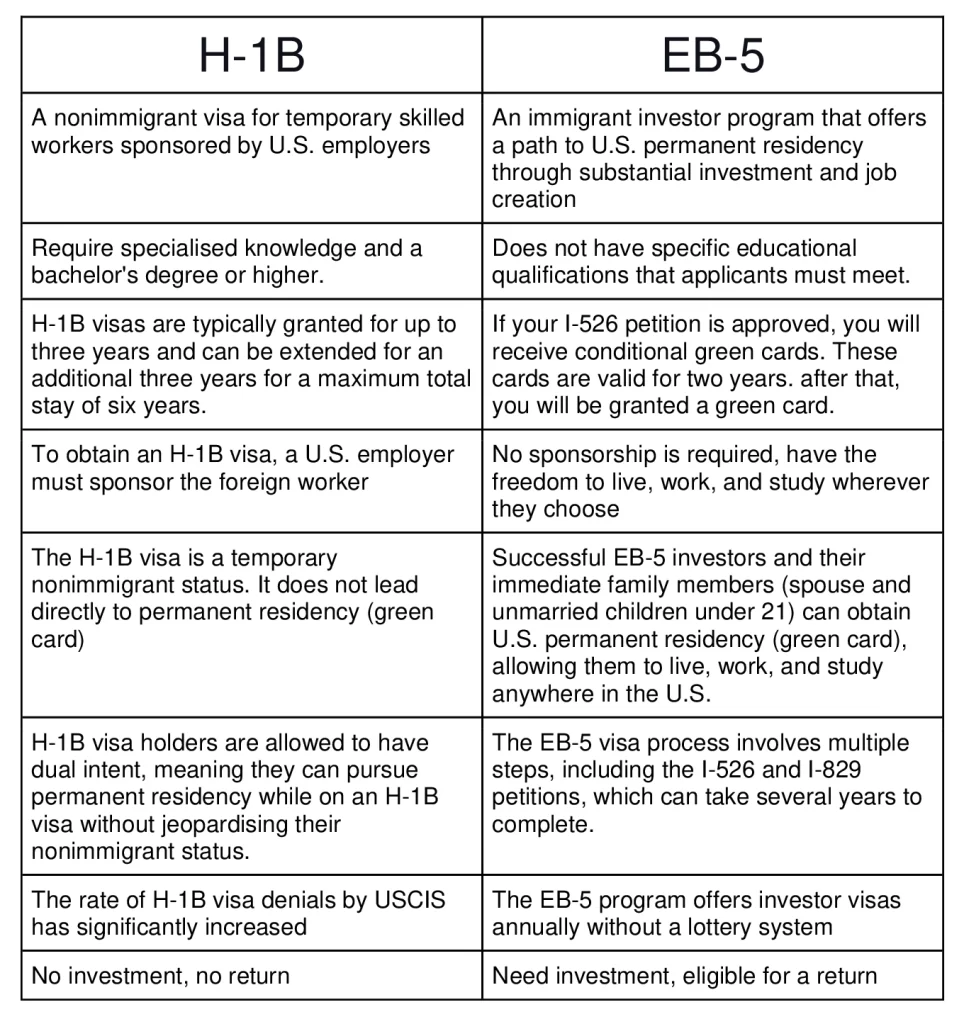



It is a work visa that permits U.S. employers to recruit foreign workers with unique skills to work in the United States for a specific duration. Usually, these job roles require a bachelor’s degree or its equivalent. The H-1B visa covers a range of professions, including technology, finance, engineering, architecture, and more.
Due to high demand, only a limited number of visas can be issued annually. As of 2023, the cap stands at 65,000 visas per fiscal year. For those with a master’s from any U.S. institution, they can avail of 20,000 visas reserved for people with a master’s degree or higher.
Remember, the H-1B visa is valid for three years and can be extended to six years. However, after reaching the six-year maximum, H1B holders must exit the U.S. and stay outside for a minimum of one year before qualifying for another six years of H1B.
USCIS administers the EB-5 Program. Individuals who are investors, along with their spouses and unmarried children under the age of 21, will be eligible to apply for Green Card status if they do,
Capital Investment
Job Creation
Congress established the EB-5 Program for U.S. economic growth by encouraging foreign investors to create jobs and invest capital. In 1992 Congress established the Immigrant Investor Program, the Regional Center Program. This program sets aside EB-5 visas for individuals who invest in commercial enterprises linked to USCIS-approved regional centres that have submitted proposals to stimulate economic growth.
To qualify for the EB-5 visa, the applicant must invest in a company created after November 29, 1990. The EB-5 program requires a minimum investment in a new commercial enterprise. The minimum investment is generally $1.8 million. Still, it may be reduced to $900,000 if the investment is made in a targeted employment area (TEA), an area with high unemployment or a rural area. The company must also be for-profit and fall under one of the following categories: Corporation, Business Trust, Joint venture, Sole proprietorship, Partnership, Holding company, or Other publicly or privately owned structure. The investment can come in various forms, including cash, equipment, inventory, other property, or secured debt.
Get immigration payments moving faster through Unimoni! Unimoni India is an NBFC and AD II category holder licensed by RBI that provides services such as international remittance, domestic money transfer, foreign exchange, payment solutions, and travel. In India, Unimoni has a widespread network of 300+ branches and 15000+ agents that offer services to individuals and businesses and is a global provider of financial services in over 160 countries.
Reach us: https://remitforex.com/services/contact.html
Your investment project must create and maintain at least 10 full-time jobs for qualifying U.S. workers within a specified time frame (usually 2 years). These jobs can be direct jobs (positions within your own company) or indirect jobs (jobs created through the economic impact of your investment).
Benefits of the EB-5 investor visa?
Eligible investors can enjoy numerous advantages through the EB-5 visa program, such as the opportunity to attain permanent residency in the United States, unrestricted travel between countries, access to world-class educational and healthcare systems, and a potential pathway towards U.S. citizenship.
Read on to learn some advantages of switching from H-1B to EB-5.
The H-1B visa grants admission to the United States for up to three years, with a possible extension of up to six years. On the other hand, the EB-5 visa is an investor visa that offers a more straightforward path to permanent residency. Once the I-526 application is approved, EB-5 applicants may receive their two-year conditional green card (depending on any country-specific backlogs). After two years, they can apply to remove the conditions and receive permanent resident status. Obtaining permanent U.S. residency can be a quick and straightforward process using the EB-5 visa.
One of the biggest challenges for foreign professionals is finding an employer willing to sponsor their H-1B visa. The H-1B visa’s dependence on sponsorship can prevent them from advancing their careers and earning higher pay if they cannot freely move to a different job or company.
The EB-5 visa, on the other hand, does not require employer sponsorship and does not depend on language proficiency, business management experience, or advanced educational degrees. With the EB-5 visa, holders can work for any employer they choose, switch employers as they please, and even start their own business or move their existing business to the United States.
One important reason to consider switching from an H-1B visa to an EB-5 visa is the restrictions placed on H-1B visa holders. These individuals are required to work and live where their employer sponsor dictates. On the other hand, EB-5 visa holders have the freedom to live, work, and study wherever they choose.
The EB-5 visa is granted to the investor, their spouse, and all unmarried children under 21, so these privileges extend to the entire family. However, with an EB-5 visa, the investor, spouse, and children can work and study without sponsorship. They can pursue their careers in the United States and earn as many advanced degrees as they desire.
Recent government data shows that the rate of H-1B visa denials by USCIS has significantly increased. The denial rate for initial employment has risen from 6% in 2015 to 24% as of the third quarter of 2019. Additionally, the H-1B annual cap of 65,000 visas was reached within five days from 2014 to 2020, while it took over 200 days to get the quota in 2012. These factors make obtaining or renewing an H-1B visa more complex.
However, the EB-5 program offers 10,000 investor visas annually without a lottery system. Foreign investors who can invest a minimum of USD 900,000 in legally sourced funds in a U.S.-based business are eligible to apply. The investor and his family, including unmarried children under 21, can obtain permanent green cards by sponsoring this amount.
One of the main differences between H-1B and EB-5 visas is that EB-5 is an investor visa that requires a minimum investment of $900,000 in a U.S. business. This investment is eligible for a return, and the USCIS oversees the EB-5 investor visa program.How to Apply
To obtain an EB-5 investor visa, the applicant must submit
Form I-526 along with proof of the following:- Investment in a for-profit business that meets the criteria above
– Confirmation that the area is a TEA, if applicable
– Involvement as a manager in the business
– Creation of 10 new jobs, as specified in the previous section
– For troubled businesses, maintaining the same number of employees for 2 years after the investment
After the approval of Form I-526, the applicant can initiate the green card application process. The process varies based on the applicant’s circumstances. Those outside the U.S. complete Form –Application for Immigrant Visa and Alien Registration-DS-260 and undergo a medical exam. They will then have to attend an interview at the U.S. Embassy or consulate, carrying the necessary documents. If the applicant is living in the U.S., they must follow the Adjustment of Status process, which involves submitting Form I-485 and, in many cases, attending an interview.
Once the application is approved, the applicant and their family associated with it will be granted a 2-year valid green card subject to certain conditions. The processing times for EB-5 visas can be inconsistent. The initial request, or Form I-526, may take anywhere from 47 to 71 months to be processed. The applicant will then need to verify if a visa is available. Currently, there are no waiting periods for EB-5 applicants.

So why delay?
Please note:
The choice between H-1B and EB-5 depends on an individual’s goals, circumstances, and eligibility criteria. It’s recommended to consult with immigration professionals to determine the most suitable option based on your situation.
For any support, please reach us: https://www.unimonitravel.com/contact




